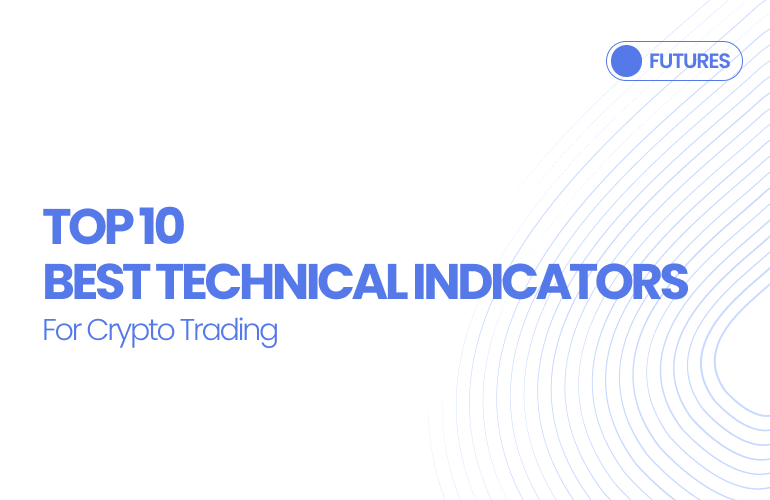Crypto trading is highly volatile, making it essential for traders to use technical analysis to make informed decisions. Technical analysis for crypto involves studying historical price data, market trends, and volume to predict future price movements. By utilising the best indicators for crypto trading, traders can gain an edge in identifying entry and exit points, reducing risks, and maximizing profits.
10 Best Technical Indicators for Crypto Trading
Technical indicators are mathematical calculations based on price, volume, or open interest that help traders analyze market trends. Below are the 10 best crypto indicators that every trader should consider:
1. Relative Strength Index (RSI)
RSI is a tool that helps traders see if a stock or asset is moving too fast in one direction. It gives a score between 0 and 100:
- Above 70 → The asset might be overbought, meaning the price could be too high and may drop soon.
- Below 30 → The asset might be oversold, meaning the price could be too low and may rise soon.
Traders on Pi42 can use RSI to spot potential trend reversals and time their trades better when trading perpetual futures. It helps them decide when to enter or exit a trade based on market momentum..
2. Moving Average (MA)
- A Moving Average (MA) is a tool that helps traders see the overall trend of a stock by smoothing out daily price ups and downs. Instead of looking at individual price movements, it calculates an average over a set period to show whether the price is generally going up, down, or staying steady. There are two main types of moving averages:
- Simple Moving Average (SMA) – This is the basic type of moving average. It adds up the closing prices of a stock over a certain number of days (like 10, 50, or 200) and then divides by that number. It gives a steady trend but reacts slowly to price changes.
- Exponential Moving Average (EMA) – This works like the SMA but gives more importance to recent prices. That means it reacts faster to price changes, making it useful for traders who want to spot trends or reversals quickly.
3. Moving Average Convergence Divergence (MACD)
MACD is a tool that helps traders figure out whether a stock is gaining or losing momentum. It does this by comparing two moving averages (one that reacts quickly to price changes and one that reacts more slowly). Here’s how it works:
- When the MACD line crosses above the signal line, it’s a sign that prices might go up (bullish signal).
- When the MACD line crosses below the signal line, it suggests prices might go down (bearish signal).
4. Bollinger Bands
Bollinger Bands help traders understand whether a stock or asset is trading at high or low levels compared to its usual price range. They consist of:
- A middle line, which is a moving average (shows the average price).
- An upper band, which marks the higher price range.
- A lower band, which marks the lower price range.
When the price touches the upper band, the asset might be overbought (the price could drop soon). When the price touches the lower band, the asset might be oversold (price could rise soon).
Read More: Bollinger Bands Explained: What They Are and How to Use Them
5. Fibonacci Retracement
Fibonacci levels are key price points where an asset, like Bitcoin or Ethereum, might slow down, reverse, or continue its trend. These levels—23.6%, 38.2%, 50%, 61.8%, and 78.6%—help traders identify support (where prices stop falling) and resistance (where prices stop rising).
Among these, the 50% and 61.8% levels are especially important since many traders watch them closely. If the price bounces off these levels, it could continue in the original direction. That’s why Fibonacci retracement is widely used in crypto trading to spot entry and exit points, confirm trends, and predict price movements.
6. Stochastic Oscillator
The Stochastic Oscillator is a popular tool used in crypto trading to measure price momentum and potential trend reversals. It compares a cryptocurrency’s closing price to its price range over a set period (typically 14 days), helping traders determine if the market is moving too far in one direction.
Here’s how it works –
- Above 80 → Indicates strong upward movement, suggesting the asset may be due for a pullback.
- Below 20 → Signals significant downward pressure, meaning a price rebound could be likely.
Why Crypto Traders Use Stochastic Oscillator
- Pinpoints Entry & Exit Points – Helps traders decide when to buy or sell based on momentum shifts.
- Confirms Trend Reversals – Becomes even more reliable when used alongside indicators like RSI or Fibonacci retracement.
- Flexible for Any Strategy – Useful for both short-term trades and long-term market analysis.
7. On-Balance Volume (OBV)
On-Balance Volume (OBV) is a powerful indicator that measures buying and selling pressure by analyzing trading volume rather than just price movements. It helps traders determine whether a cryptocurrency is being accumulated (bought heavily) or distributed (sold off), which can provide insight into future price trends. How OBC works:
- Rising OBV → Indicates strong buying pressure, meaning traders are accumulating the asset. This often signals a bullish trend, suggesting that prices may continue to rise.
- Falling OBV → Shows increasing selling pressure, meaning more traders are offloading their holdings. This points to a bearish trend, where prices could decline further.
8. Ichimoku Cloud Indicator
The Ichimoku Cloud is a powerful technical indicator that offers a detailed view of support, resistance, momentum, and trend direction. Unlike single-line indicators, it consists of multiple components that work together to give traders a comprehensive market outlook.
Key Components of the Ichimoku Cloud
- Kumo (Cloud) – The shaded area that represents future support and resistance zones. A price above the cloud suggests a bullish trend, while a price below indicates a bearish trend.
- Tenkan-sen (Conversion Line) – A short-term trend indicator that reacts quickly to price changes.
- Kijun-sen (Base Line) – A medium-term trend indicator that helps confirm signals from the Tenkan-sen.
Why Crypto Traders Use Ichimoku Cloud
- Identifies Trend Direction – If the price stays above the cloud, the trend is strong; if it drops below, the trend is weakening.
- Detects Potential Reversals – Crossovers between the Tenkan-sen and Kijun-sen signal possible trend changes.
- Confirms Entries & Exits – Traders use the cloud to find ideal points to enter or exit trades, especially in crypto futures trading where precision is key.
Continue Reading: What is Ichimoku Cloud? How to use it to trade cryptocurrencies
9. Average Directional Index (ADX)
The Average Directional Index (ADX) is a key indicator that helps traders measure the strength of a trend rather than its direction. It ranges from 0 to 100, with higher values indicating stronger trends and lower values suggesting weak momentum.
- Values above 25 – Signals a strong trend, meaning the price movement has momentum and could continue in the same direction.
- Values below 20 → Indicates weak momentum, suggesting that the market may be ranging or lacking a clear trend.
10. Parabolic SAR
The Parabolic SAR (Stop and Reverse) is a trend-following indicator that helps traders identify trend direction and potential reversal points. It places small dots (also called SAR points) above or below price action, making it easy to visualize momentum shifts.
How Parabolic SAR Works in Crypto Trading –
- Dots Below the Price → Signals a bullish trend, suggesting upward momentum.
- Dots Above the Price → Indicates a bearish trend, meaning downward pressure is increasing.
- Dot Reversals → When the dots switch sides, it may signal a potential trend reversal.
Conclusion
Technical indicators play a crucial role in crypto technical analysis, helping traders make data-driven decisions. While no single indicator guarantees success, using a combination of these indicators for crypto trading can significantly improve accuracy.

